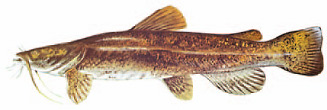 Scientific Name
Scientific Name
Pylodictis olivaris
Other Common Names
mud cat, shovelhead cat, yellow cat
Identification
Broadly flattened head with a lower jaw that projects beyond the upper jaw. Tail only slightly notched and adipose fin is relatively large. Body is yellowish or cream-colored, with black, dark brown or olive-brown mottling on back and sides, fading to dirty white or yellow. Younger fish have darker, bolder markings and the upper tip of the tails have white, triangular patches.
Best Fishing
Rivers: James, New, Staunton/Roanoke and Occoquan Creek. Lakes: Occoquan, Claytor and, Flannagan, Smith and Buggs Island.
Fishing Techniques
Use live bait since they aren’t easily attracted to catfish baits normally used for other catfish, although chicken entrails, nightcrawlers, and minnows work well. Usually caught on the bottom of deep pools or in tailraces below dams.
Feeding Habits
More solitary than other catfish. Omnivorous, they feed at night on almost anything, including other fish, crustaceans, mollusks, insect larvae and terrestrial creatures washed into the river. More than other catfish they feed on other live fish. Sometimes they feed near the surface and occupy water shallower than most catfish.
Habitat
Found in large, rivers, inhabiting deep, slow stretches near strong currents. Prefers structure like submerged logs, brush, rip rap, and underwater piles of debris.
Spawning Habits
Summer, when water temperatures reach 72° to 84°F. Eggs are laid in depressions scooped out of the bottom, in hollow logs or in holes along the bank. After hatching, fry gather in compact schools guarded by the male. As they grow older, they become solitary.


